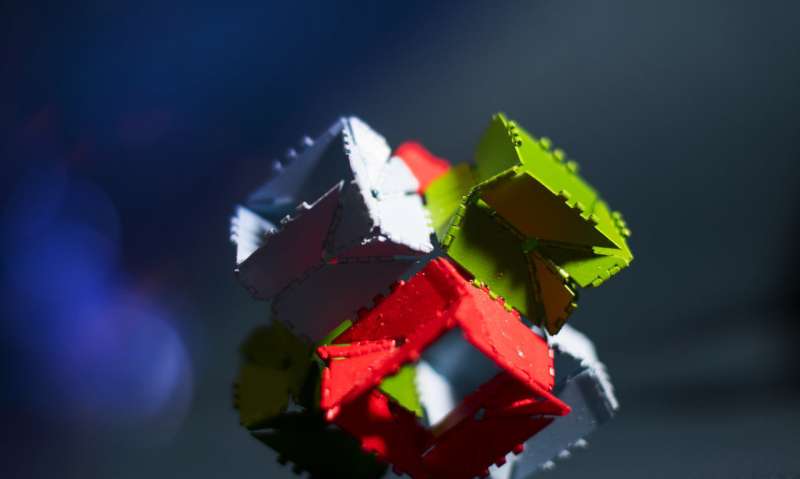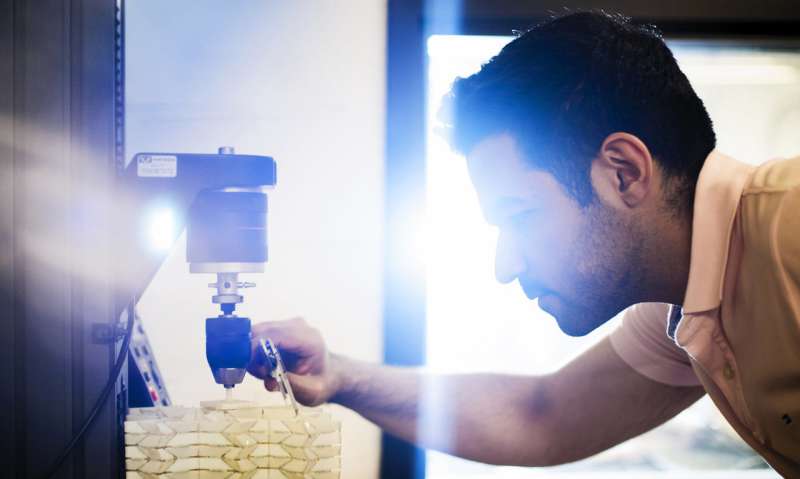How origami might reshape the future of everything

The next generation of solar panels and air bags will be shaped by the ancient Japanese art of paper folding.
At least, that's how Northeastern researcher Soroush Kamrava sees it.
The third-year doctoral student in mechanical engineering uses 3-D printers in the Machine Shop on campus to create smart structures—objects that can collapse, absorb energy, and spring back into place using the geometric principles of origami.
"Origami is a branch of art that only uses geometry, which is the same base for mechanical structures," said Kamrava.
Traditional origami uses paper. However, most engineering applications require materials with definitive thickness and enough strength and stiffness to properly perform. That's where metamaterials come in. Substances that aren't found in nature, such as plastic, metal and rubber, metamaterials form the basis of Kamrava's work.
An origami expert can turn a few basic folds into a complex design. The challenge for engineers is to create a system of folds that is structurally sound and can be reproduced.
Kamrava uses metamaterials to replicate patterns and shapes he encounters everyday. "Our work is a combination of science and art," he said. "So sometimes inspiration comes from a museum, old architecture, or just floor tiles."
Kamrava produces a paper version of the design with an origami printer. He then plays with the sample, folding it and unfolding it, to ensure it can be replicated using stronger materials.
Once that's confirmed, 3-D printers fabricate geometric-shaped pieces in the desired metamaterial, usually plastic, which can sometimes take hours depending on each piece's size.

Kamrava assembles the final structure using metal hinges to mimic origami paper folds. Applying a small amount of pressure changes the structure's shape. Since the hinges absorb the stress, the change can be made again and again.
His research focuses on the smart structure's deployability, which is the ability to expand strategically without creating defects in the actual structure. Kamrava calculates the functional application of structures based on their agility.
"For example, if you want to send a large structure to space, it's going to be expensive," he said. "So scientists can design a deployable structure that folds into a smaller volume for the journey, but can expand back into its original shape when it arrives."
Smart structures are not robots, which use electronics. Smart structures simply change their shape based on a response to a change in the environment.
From inception to assembly, it takes about a year to make a single smart structure. Kamrava works with a team of graduate and undergraduate students and his adviser Ashkan Viziri, a professor of mechanical and industrial engineering.
Viziri, who studies high performance materials, acknowledged Kamrava's work ethic and innovative approach to creating origami-inspired metamaterials.
"Soroush has done an excellent job making sure that he is independent," Viziri said. "He's always thinking about the next idea and how he can expand what he has already done, which I think is a critical part of anyone's education at the Ph.D. level."
One day, Kamrava hopes to use origami-inspired meta-materials to create smart structures that could be used to harvest renewable energy. But for now, he's still experimenting.
"Smart materials is an ongoing field of research," he said. "In my view, coming up with the idea is the best part."
Provided by Northeastern University





















